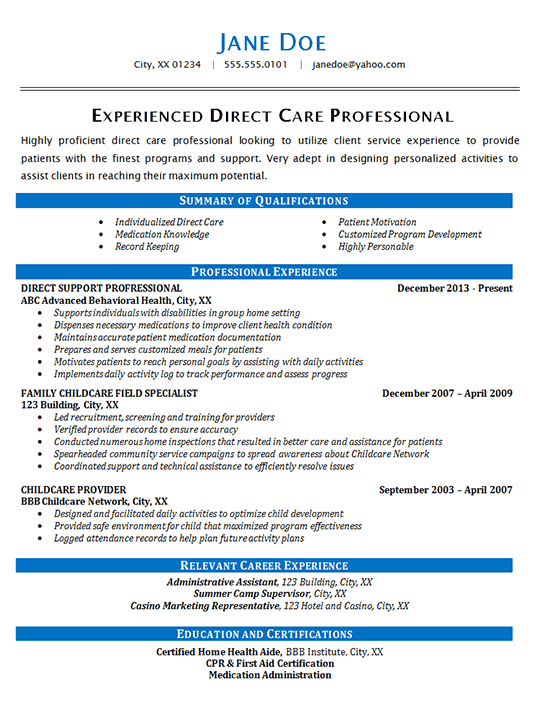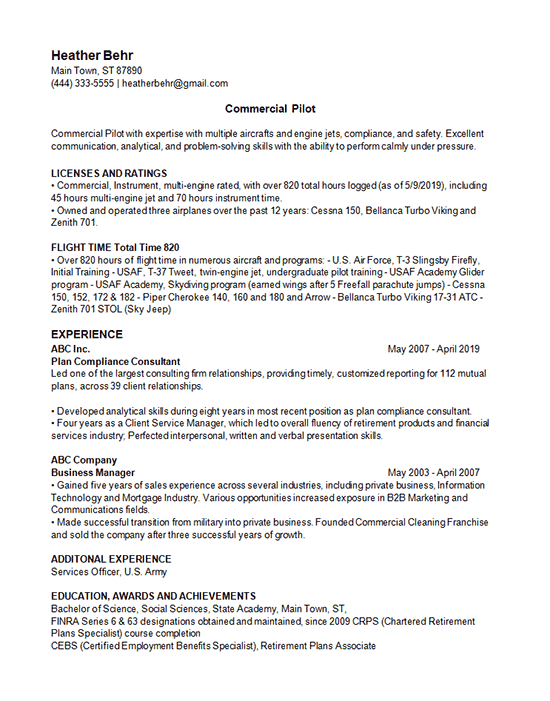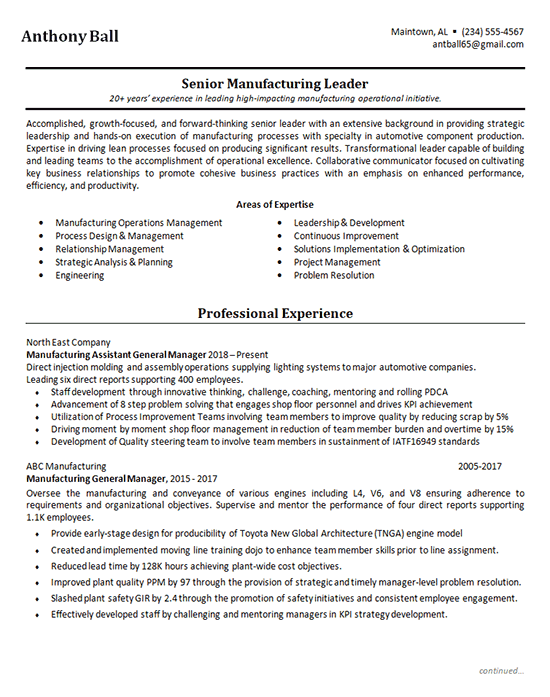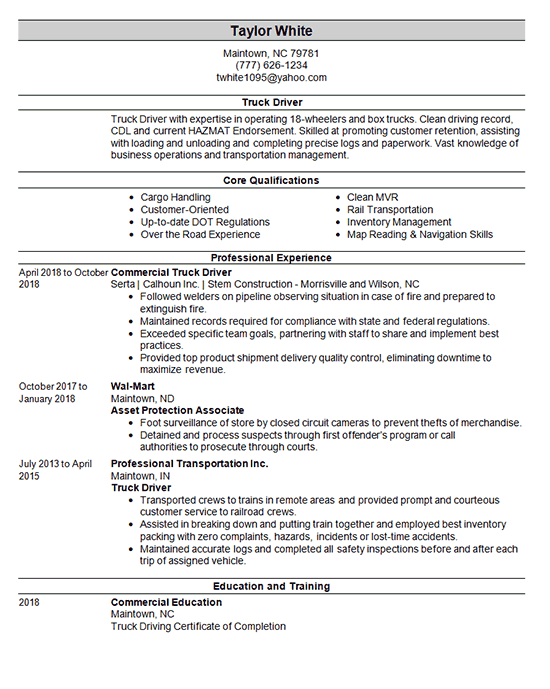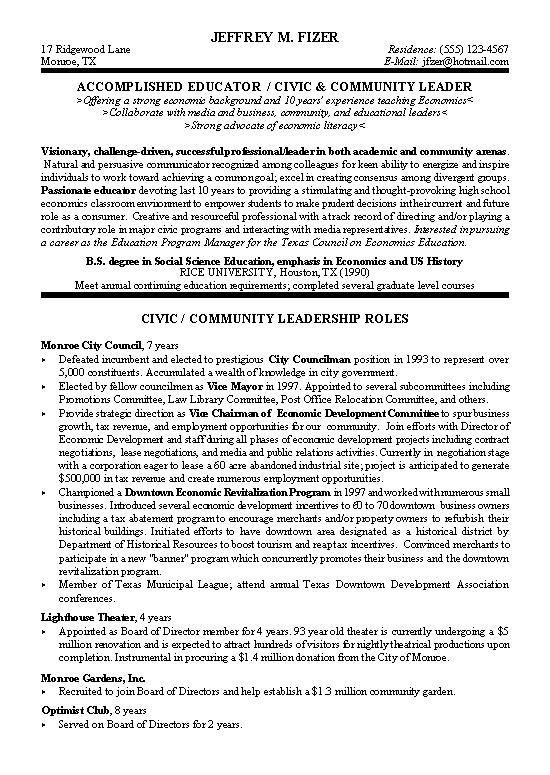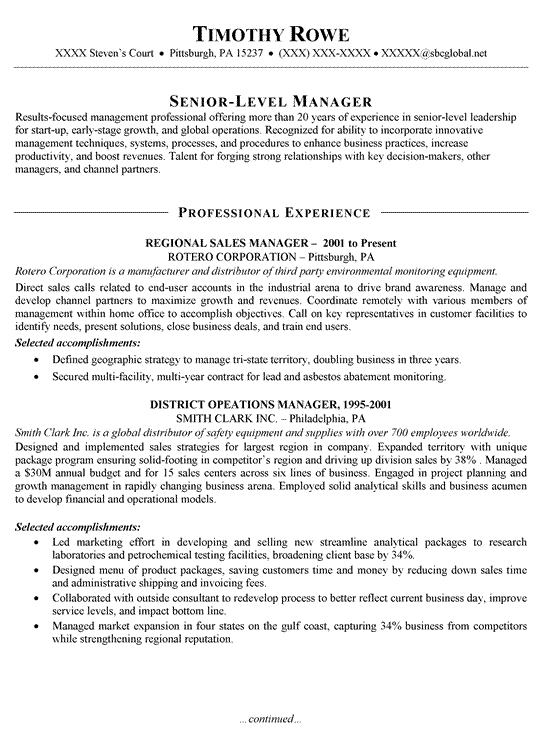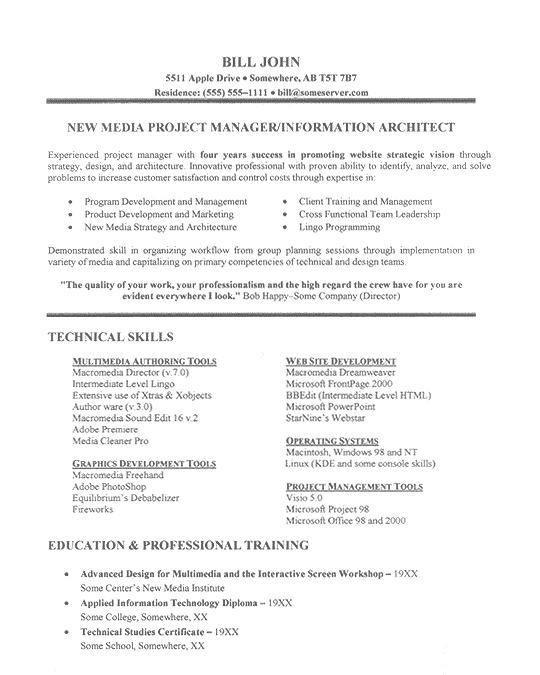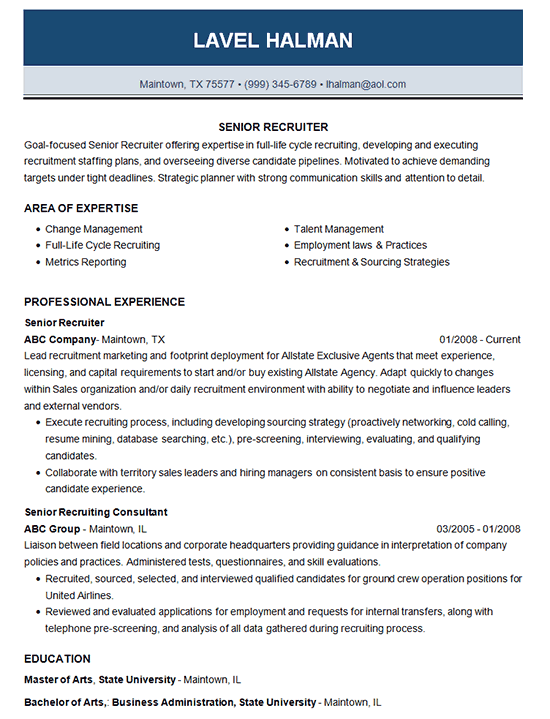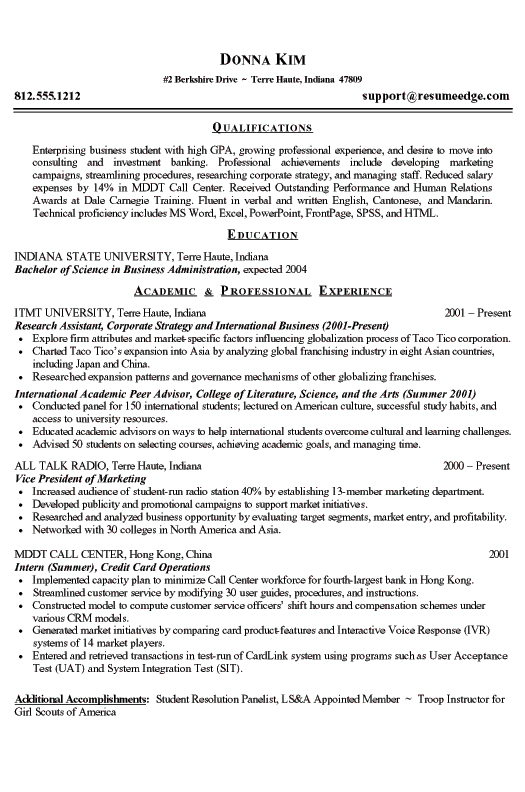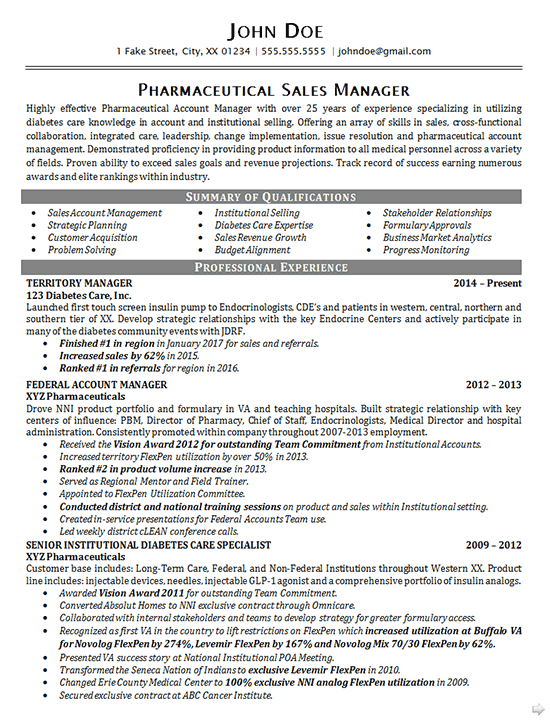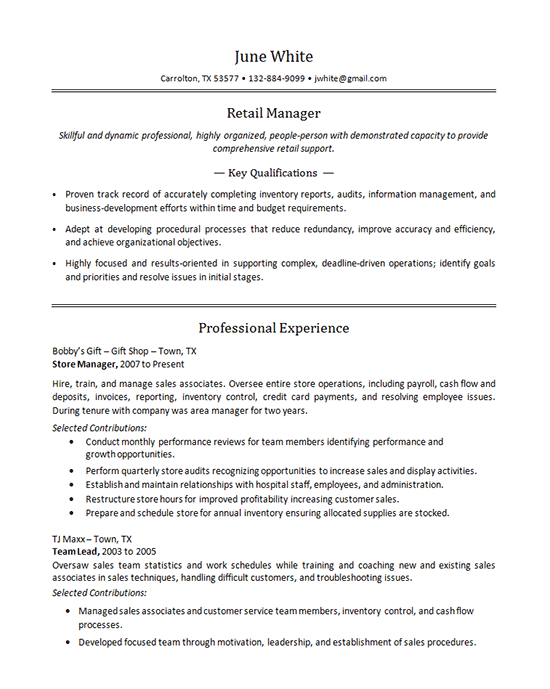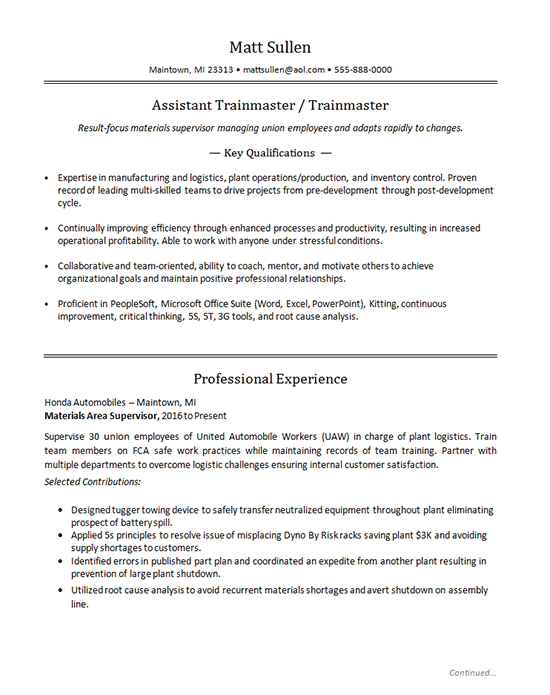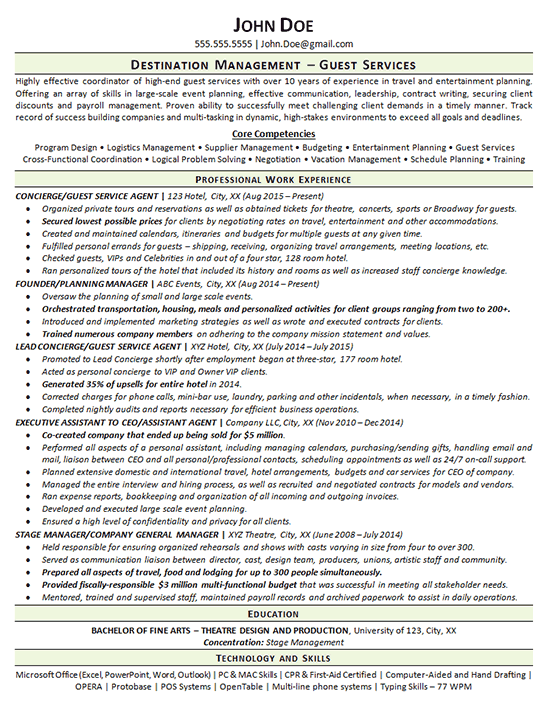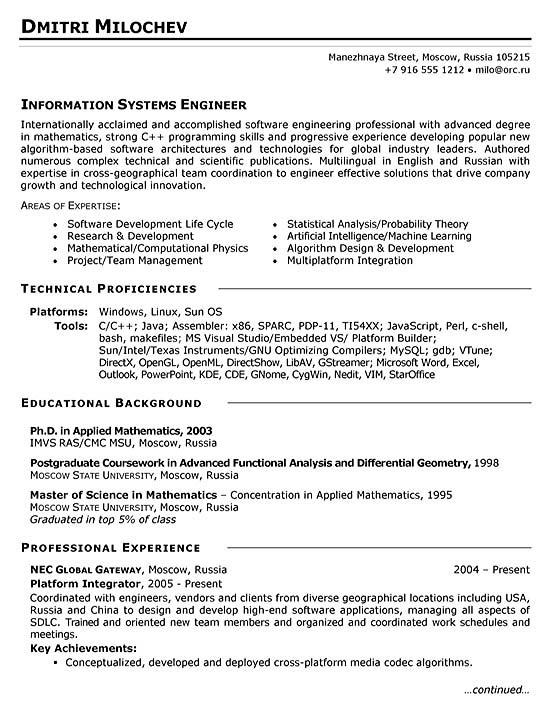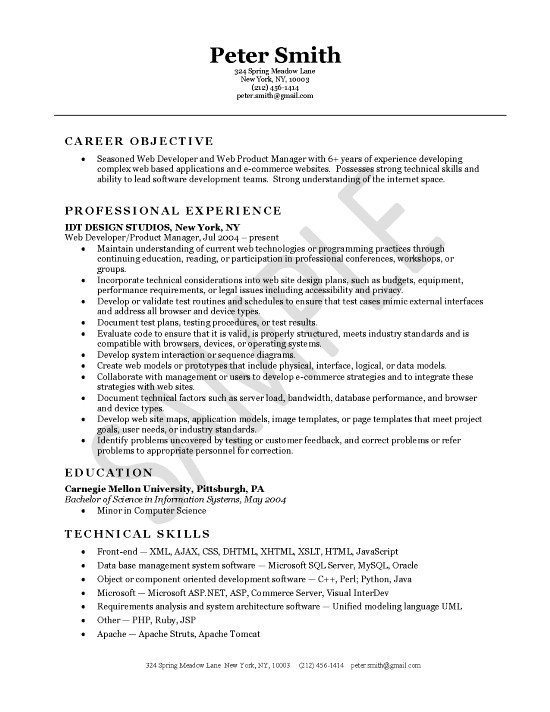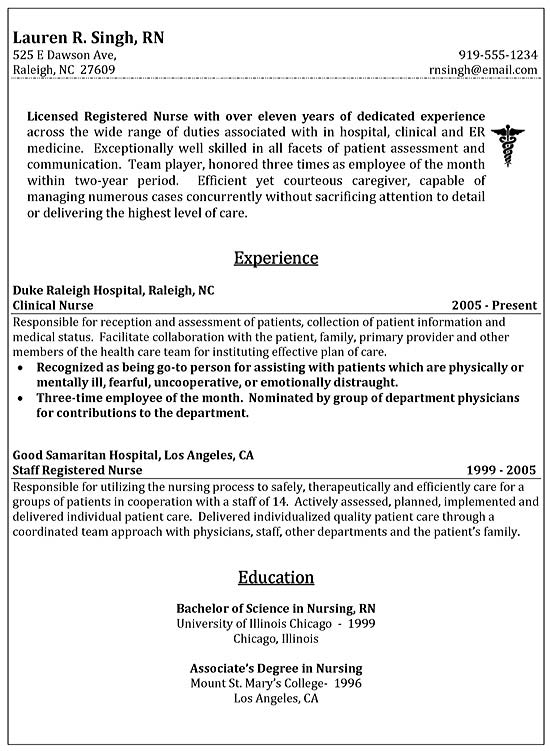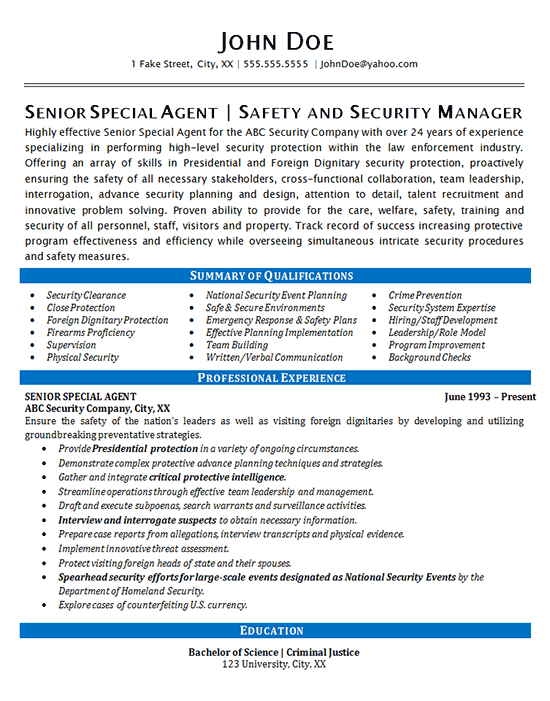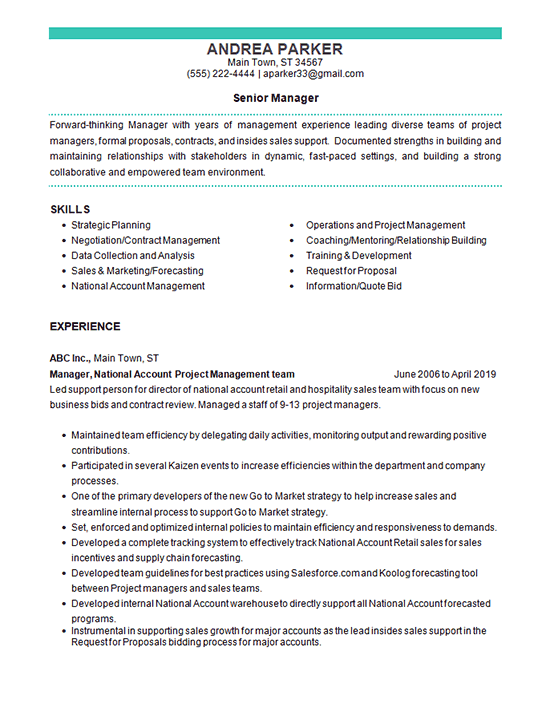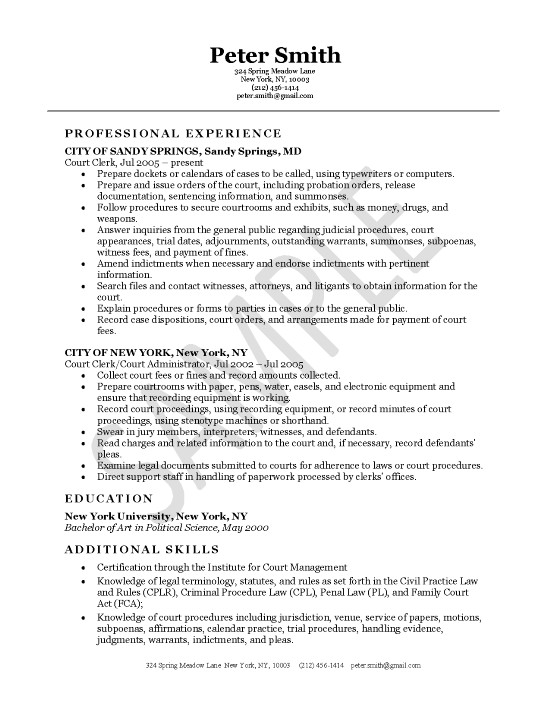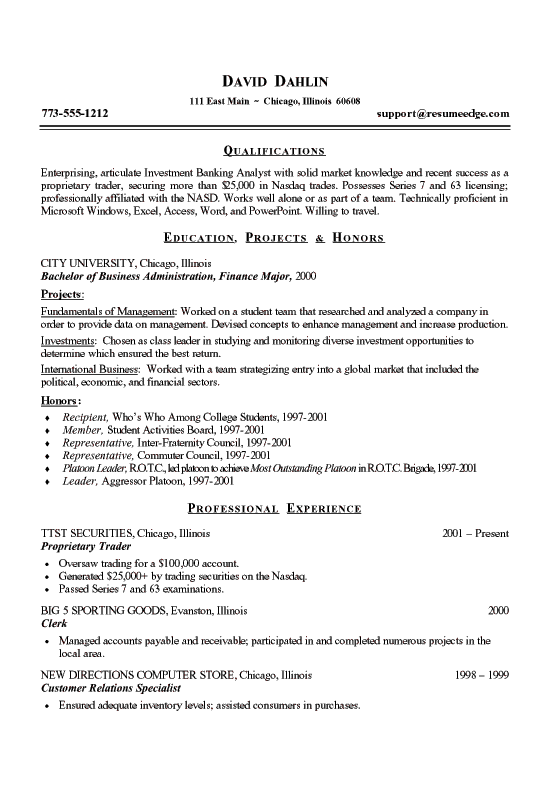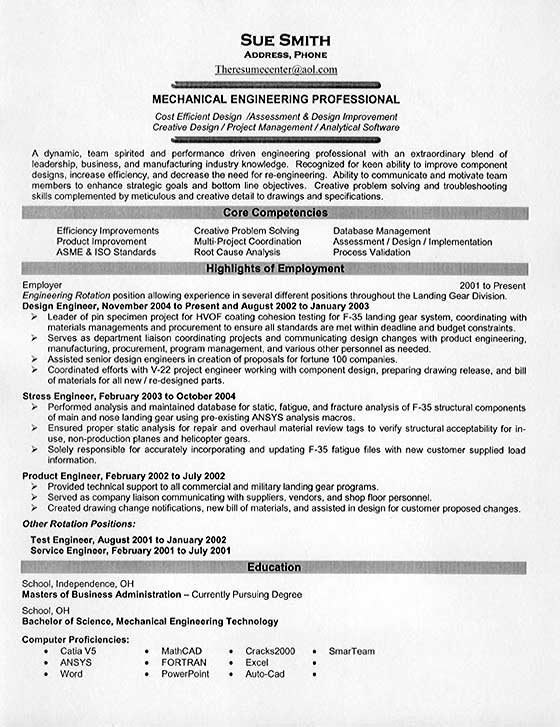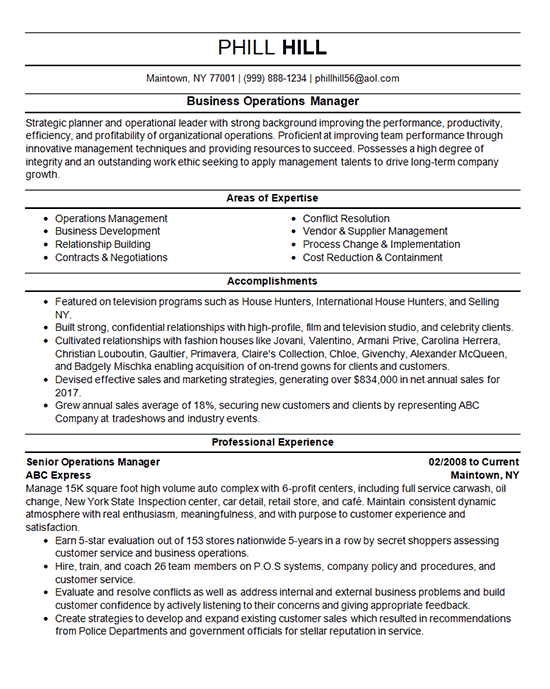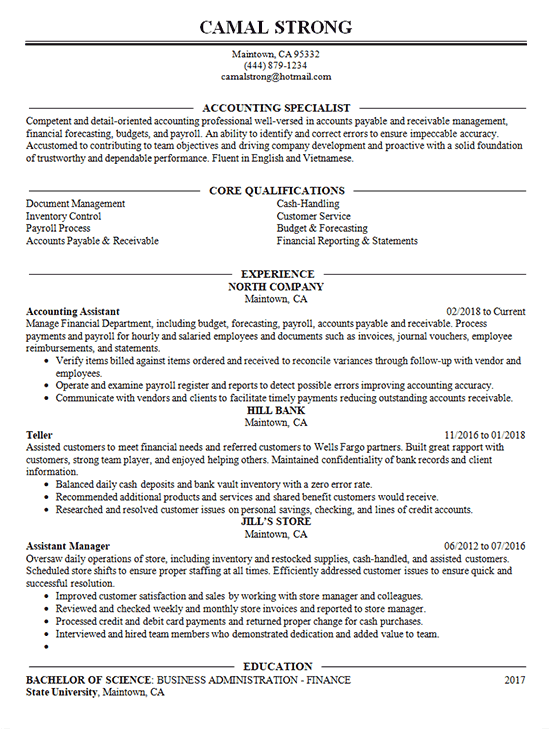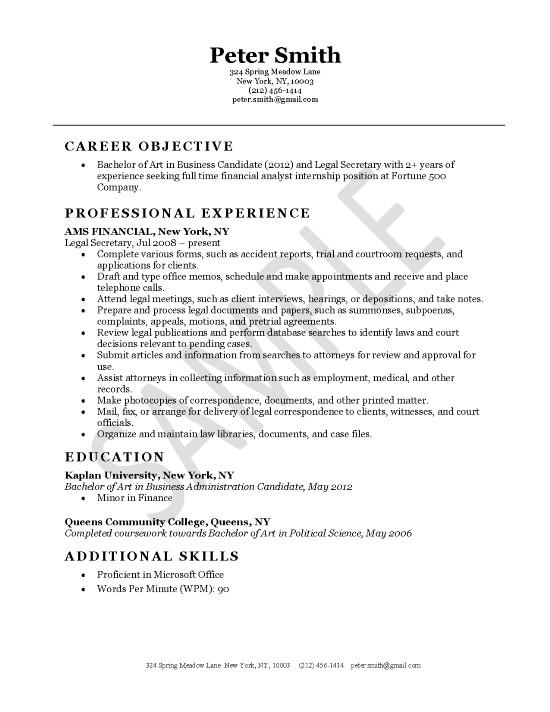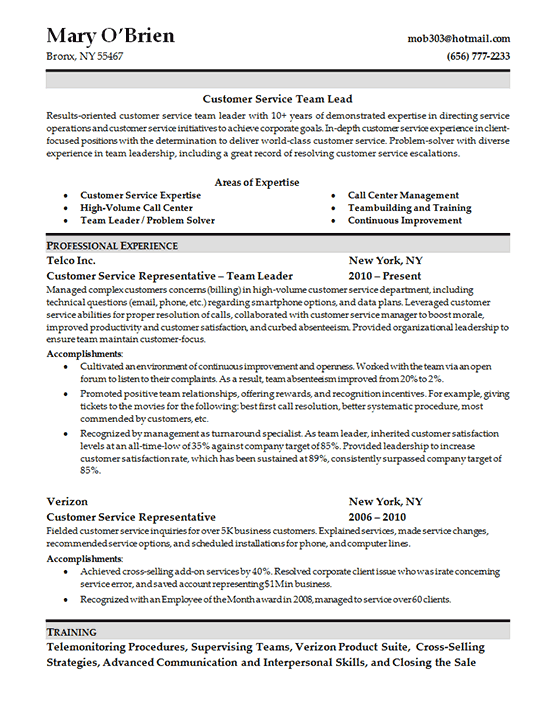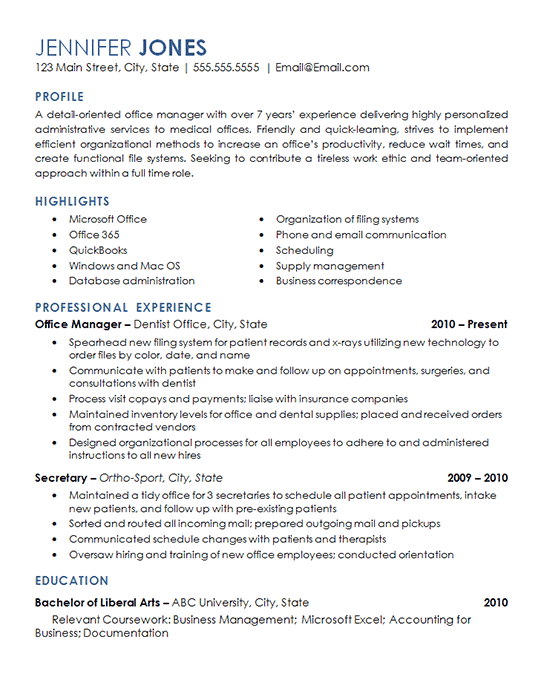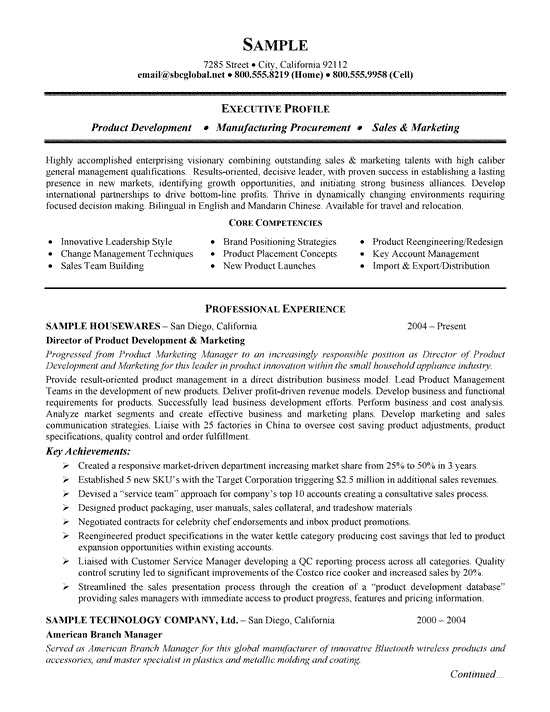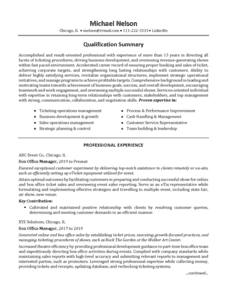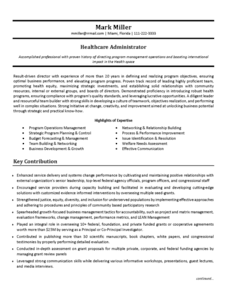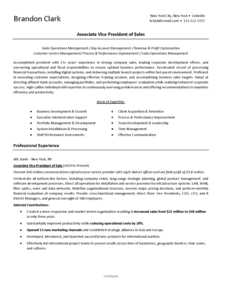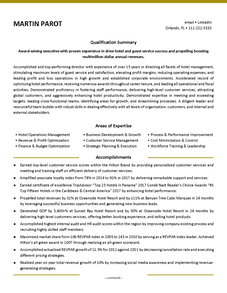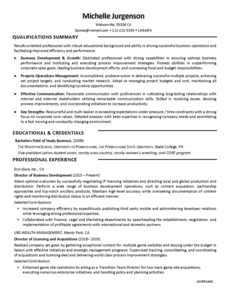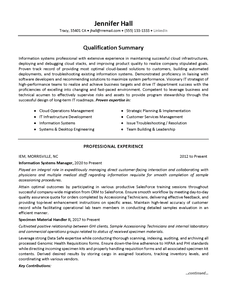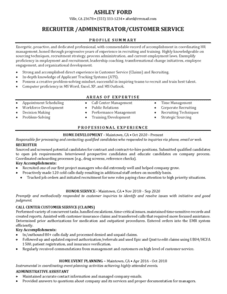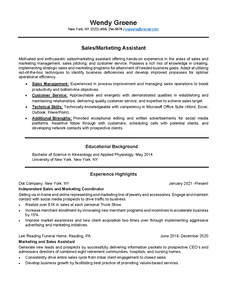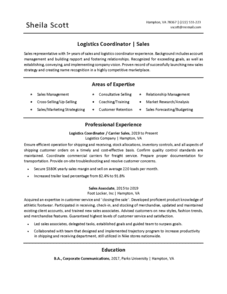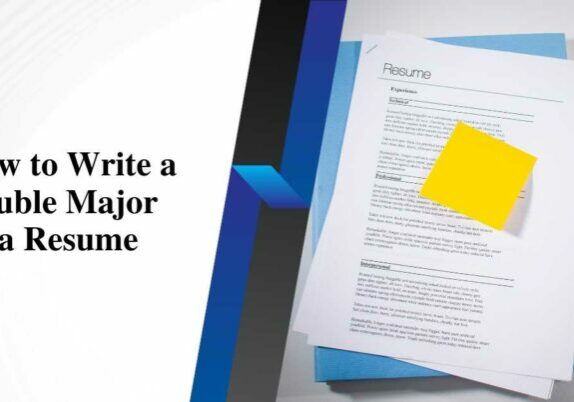The job seeker in this resume has one specific job target with over 7 years of experience in the position of Staff Accountant. The resume is written in a functional style that includes a summary, full documentation of experience, simple listing of work history and education. This style is appropriate since the roles and responsibilities are virtually identical in each job position.
The summary paragraph identifies the key points that separate the candidate from the competition. The writer emphasizes knowledge of fiscal operations, business administration, ad hoc reporting, closing, analysis and other areas. You will also notice a mention of leadership, collaboration and planning. The last sentence documents specific accounting software that would be a necessary requirement for the job.
The experience section uses a bullet list to document specific responsibilities or achievements. A few of the more influential statements are in bold format, such as ensuring optimum inventory levels or resolving discrepancies with bank postings. Below experience the name, city, title and dates are listed from present to past. The education section lists the Bachelors degree in Accounting.
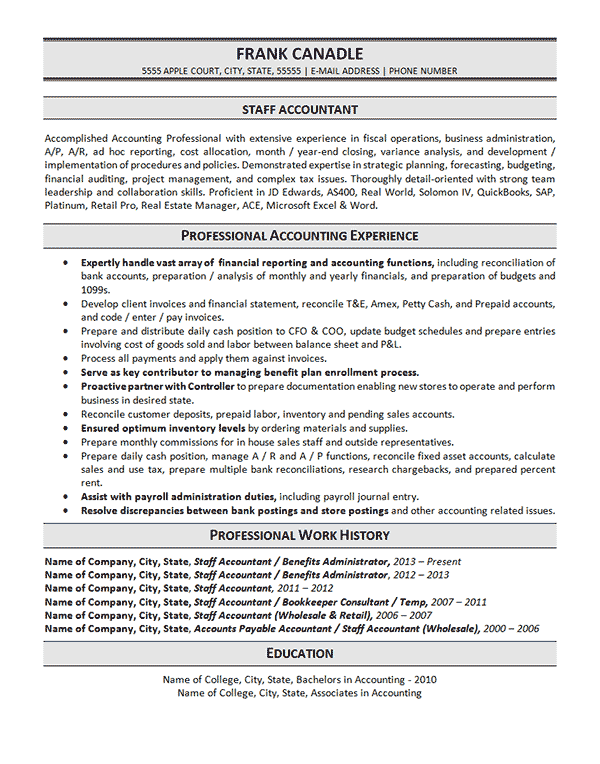
Staff Accountant Resume Example
Staff Accountant Resume Example Statements
- Expertly handle vast array of financial reporting and accounting functions.
- Develop client invoices and financial statements.
- Prepare and distribute daily cash position to CFO and COO.
- Process all payments and apply them against invoices.
- Proactive partner with Controller to prepare documentation enabling new stores t operate and perform business in desired state.
- Reconcile customer deposits, prepaid labor and pending sales accounts.
- Ensured optimum inventor levels by ordering materials and supplies.
- Prepare monthly commissions for in house sales staff and outside representatives.
- Prepare daily cash position, manage A/R and A/P function.
- Handle a vast array of financial reporting and accounting functions.
- Managed reconciliation of bank accounts, analysis of periodic financials, and preparation of budgets.
- Develop invoices and financial statements for clients.
- Reconcile T&E, Amex, Petty Cash, and Prepaid accounts.
- Prepare and distribute daily cash position to management.
- Update budget schedules and prepare entries involving cost of goods sold and labor.
- Process all payments and apply them against invoices.
- Prepare monthly commissions for in house sales staff and outside representatives.
- Assist with payroll administration duties, including payroll journal entry.
Accountant Resume Writing Tips
Are you looking to land your dream job as an accountant? Your accountant resume is the key to making a lasting impression on potential employers. Your resume should showcase your skills, achievements, and experience in a way that highlights your qualifications and sets you apart from other candidates.
With the correct format, language, and content, your resume can help you stand out in a highly competitive job market. In this article, you’ll learn how to create an outstanding accountant resume that impresses hiring managers and secures an interview.
You’ll discover tips for formatting your resume correctly, crafting a compelling summary or objective, showcasing your work experience, and highlighting the top skills employers seek in an accountant. Whether you’re an experienced accountant or just starting, this article will provide everything you need to create a job-winning accountant resume in 2023.
What Is an Accountant Resume?
If you want to land your dream job as an accountant, you need to know what an accountant resume is and how to make yours stand out from the competition.
An accountant resume is a document that outlines your work experience, education, skills, and achievements as an accountant. It’s used by hiring managers to determine if you’re a good fit for a job opening in their company.
To make your resume stand out, follow a specific format tailored to the job description. The resume format should be clear and easy to read, with a one-page resume being the ideal length.
Your resume should include a resume summary highlighting your skills and a work experience section focusing on your achievements rather than your responsibilities. Use keywords from the job description to show you have the skills and experience the hiring manager is looking for.
How to Correctly Format an Accountant Resume
Proper formatting ensures that your resume stands out to potential employers. A well-formatted resume is easy to read and highlights your relevant skills and experience.
When creating your resume, it’s essential to use bullet points to make it easy for potential employers to scan through your experience and accomplishments quickly.
As a senior accountant, you may consider adding a certification, such as the Certified Public Accountant (CPA) designation, to your resume. This can help demonstrate your expertise and give potential employers confidence. Additionally, if you have experience in audit, highlight this in your resume objective or summary section.
When formatting your accountant resume, it’s important to remember that potential employers will likely be reviewing dozens or even hundreds of resumes. To make yours stand out, use a clean and professional font, such as Times New Roman or Arial, and include plenty of white space to make your resume easy to read.
Following these tips, you can create a well-formatted accountant resume that showcases your skills and experience.
How To Write an Effective Accountant Resume Summary or Objective
Craft a captivating career summary or objective that showcases your key qualities and quantifiable achievements to capture the attention of recruiters and hiring managers.
Your resume summary or objective should be the first thing the recruiter sees, so it’s crucial to make it count. A good summary or objective should briefly introduce yourself and highlight your most relevant skills, experience, and accomplishments.
If you’re a senior accountant, you can focus on your leadership and management skills, while entry-level accountants can emphasize their eagerness to learn and potential.
When writing your accountant resume summary or objective, it’s essential to tailor it to the job title you’re applying for. Use the job description as a guide to identify the most essential skills and qualifications the employer seeks.
Highlight your relevant soft skills, such as communication, problem-solving, attention to detail, and technical accounting skills, including knowledge of financial statements, tax laws, and accounting software. If you’re a certified public accountant, mention it here.
Remember to keep your summary or objective concise and impactful. Use bullet points to highlight your achievements and quantify your results where possible. Use contractions and action verbs to describe your accomplishments, and avoid using vague or generic statements.
Finally, don’t forget to proofread your resume summary or objective and the rest of your resume template carefully to ensure no typos or grammatical errors.
How To Make Your Accountant Work Experience Stand Out
Highlight your past accounting work experience in a way that paints a vivid picture of your skills and accomplishments, making it easy for recruiters to see why you’re the perfect candidate for the job.
The work experience section is where you can shine and impress potential employers. Use bullet points to outline your responsibilities and achievements in each role, showcasing your industry experience and expertise in accounting practices.
When highlighting your experience, it’s important to remember the best format for a resume. The reverse-chronological format is often preferred, allowing recruiters first to see your most recent experience. Additionally, focus on your top skills and how they were utilized in your previous roles.
Using numbers and specific examples can also help to back up your accomplishments and give recruiters a better understanding of your capabilities.
Pay attention to the responsibilities listed in the job description and tailor your work experience section accordingly. By highlighting relevant experience and skills, you can clarify to recruiters that you have the qualifications they seek.
Don’t be afraid to be specific and detailed in your descriptions, as this can help you stand out from other candidates. By following these tips and highlighting your experience effectively, you can create an accountant resume that grabs the attention of potential employers and lands you your dream job.
Top 5 Skills To Add to an Accountant Resume
When crafting your accountant resume, it’s essential to highlight the skills employers seek. To stand out from the competition, consider adding abilities such as knowledge of regulatory standards, software proficiency, data analysis, critical thinking, and communication skills.
These skills demonstrate your ability to handle complex financial tasks and communicate effectively with clients and team members. Include specific examples of how you’ve utilized these skills in previous roles to showcase your expertise.
Knowledge of Regulatory Standards
Regulatory standards are crucial for you to understand as an accountant. A recent survey found that 63% of accounting professionals consider keeping up with regulation changes their biggest challenge. This means that having knowledge of regulatory standards and demonstrating that knowledge on your resume can make you stand out to potential employers.
When crafting your accounting resume, it’s essential to highlight your understanding of regulatory standards. You can showcase your experience with compliance for financial statements, accounts payable, and general ledger. You can also highlight your CPA certification and any relevant training or courses you’ve taken to stay up-to-date on the latest regulations.
By demonstrating your knowledge of regulatory standards, you can show potential recruiters that you have the skills and expertise needed to excel in an accounting role.
Software Proficiency
As an accounting professional, it’s crucial to have software proficiency. This skill helps streamline processes and increase efficiency. Employers highly value software proficiency, particularly in accounting software such as QuickBooks. This software allows for accurate financial reporting and streamlined tax preparation.
In an entry-level accounting position, having software proficiency is even more critical. It demonstrates that you have the necessary skills to succeed in the accounting process and can adapt to different software systems. Be sure to highlight any experience with accounting software, including any certifications or training you may have received.
By emphasizing your software proficiency in your accountant resume, you can show potential employers that you are a valuable asset to their team.
Data Analysis
To impress potential employers and highlight your proficiency in data analysis on your accountant resume, start by including key skills such as financial analysis, statistical modeling, and data visualization. As an accountant, you are responsible for analyzing financial data and making informed decisions that drive business success.
Your accounting experience should reflect your ability to understand business trends, identify financial risks, and provide actionable insights to stakeholders. To showcase your data analysis skills, structure your experience section with resume tips from a professional resume writer. Use complete sentences on their own lines and emphasize your ability to analyze financial data and provide strategic recommendations.
Provide specific examples of how you have used data analysis to drive business results in your previous roles. Highlighting your proficiency in data analysis can increase your chances of landing your dream accounting job.
Critical Thinking
To truly stand out in the competitive job market, you must hone your critical thinking skills and demonstrate your ability to think outside the box. As an accountant, you need to have a keen eye for detail and be able to analyze information effectively.
By showcasing your critical thinking skills on your resume, you can set yourself apart from other candidates and prove that you have what it takes to drive innovative solutions and solve complex business problems. One of the best practices for resume writing is to highlight your critical thinking skills in the experience section.
For example, you can describe how you utilized your critical thinking abilities to identify financial statement discrepancies or develop a new system for tracking expenses.
Remember to use the reverse-chronological format, the preferred format in public accounting, and tailor your resume to the job description to emphasize your critical thinking skills.
Communication Skills
Now that you’ve honed in on your critical thinking skills, it’s time to focus on showcasing your communication skills in your accountant resume.
As a staff accountant, you must effectively communicate financial information to clients, team members, and management. Therefore, highlighting your communication skills in your resume is crucial to landing an accounting job.
When customizing your resume for an accountant job, showcase your skills clearly and concisely. Use bullet points to break down your experience and skills, and include any relevant experience as a junior accountant or accounting assistant.
Use action verbs to describe your accomplishments and responsibilities in your previous roles. By providing specific examples of how you’ve effectively communicated financial information in the past, you’ll increase your chances of landing your dream accounting job.
Conclusion
Congratulations! You’ve crafted an exceptional accountant resume showcasing your skills and achievements while highlighting your experience and education. Your attention to detail and dedication to accuracy will undoubtedly impress potential employers.
Your resume’s format is clean and professional, allowing your accomplishments to shine. With your well-crafted summary or objective, you’ve set yourself apart from other candidates. Your work experience is presented in a way that highlights your unique contributions to each role.
Your top skills demonstrate your ability to handle complex financial tasks with ease. You’ll stand out as a top candidate for any accounting position you apply for! Remember, your resume is your first impression, so make it count.
Tailor it to each job application and emphasize the skills and experience that are most relevant to the position. Don’t forget to include any relevant certifications or education.
With your impressive resume and cover letter, you’ll land your dream job quickly. Keep up the great work!
Frequently Asked Questions
Q: What key elements should be included in an Accountant Resume?
A: The key elements that should be included are a resume objective, relevant job experience, skills you need to perform accounting jobs, educational background, professional association you belong to, certification, and personal or contact information.
Q: What are the responsibilities listed in an Accountant Job Description?
A: This may include the following responsibilities: preparing financial statements, analyzing financial data and making recommendations, reconciling accounts, developing budgets and financial plans, preparing tax returns, managing accounts receivable, and ensuring compliance with accounting procedures and regulations.
Q: What are the best Accounting Keywords for an Accountant Resume?
A: Some of the best Accounting Keywords to use in an Accountant Resume are: Senior Accountant, Certified Public Accountant (CPA), Staff Accountant, Accounting Assistant, Great Accountant, Accounts Receivable, Accounting Services, Accounting Field, On-the-job experience, and Reconcile.
Q: What should be the format of an Accountant Resume?
A: The format should be clear, concise, and organized, with each section clearly labeled. Hiring managers may see hundreds of resumes for an Accountant position, so your resume must be easy to read and find the information they need.
Q: What should be in the Experience Section of an Accountant Resume?
A: It should include previous work experience, starting with the most recent position, and should highlight accomplishments and results. List your job experience in reverse chronological order, including your employer’s name, employment dates, job titles, and duties you performed.
Q: What are the skills that an Accountant’s Resume should highlight?
A: Some skills you should highlight are analytical and critical thinking skills, proficiency with accounting software, problem-solving, attention to detail, communication skills, and the ability to work independently and in a team.
Q: What is the importance of a Cover Letter?
A: A Cover Letter is an introduction to the hiring manager and an opportunity to highlight key accomplishments and express your interest in the position. A well-written Cover Letter demonstrates your writing skills, shows that you’ve researched the company and position, and sets you apart from the other candidates.
Q: Can an Entry-level Accountant create an effective Accountant Resume?
A: Yes, an Entry-level Accountant can create an effective Accountant Resume by highlighting relevant coursework, internships, extracurricular activities like joining accounting organizations, skills and interests, and accomplishments that demonstrate accounting skills and knowledge.
Q: Can a Certified Professional Resume Writer help create an effective Resume?
A: Yes, a Certified Professional Resume Writer can help create an effective Accountant Resume by providing suggestions on formatting, identifying missing information, highlighting accomplishments, and helping you make the most of your relevant work history and skills.
Q: How can I make my Accountant resume stand out to Recruiters?
A: To make your Accountant Resume stand out to Recruiters, you can tailor your resume to each job you apply for, using the keywords in the job listing, providing measurable achievements in your experience section, and including relevant skills at the top of your resume. You can also submit your resume to your professional association or networks to seek recommendations and referrals for job opportunities in the accounting field.

